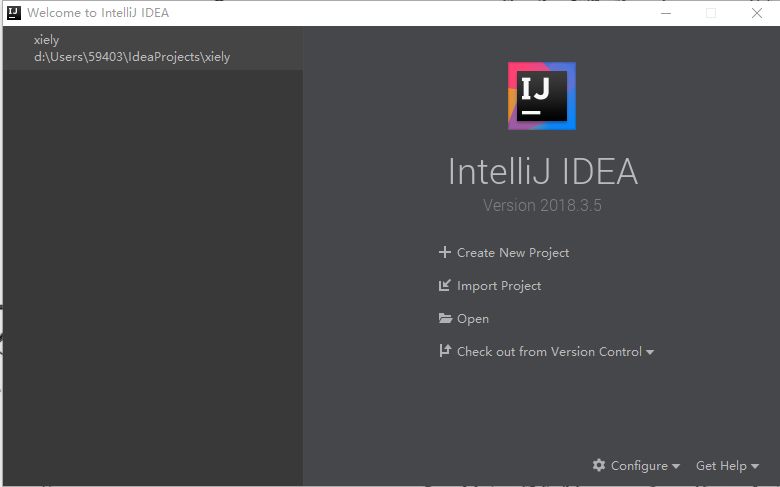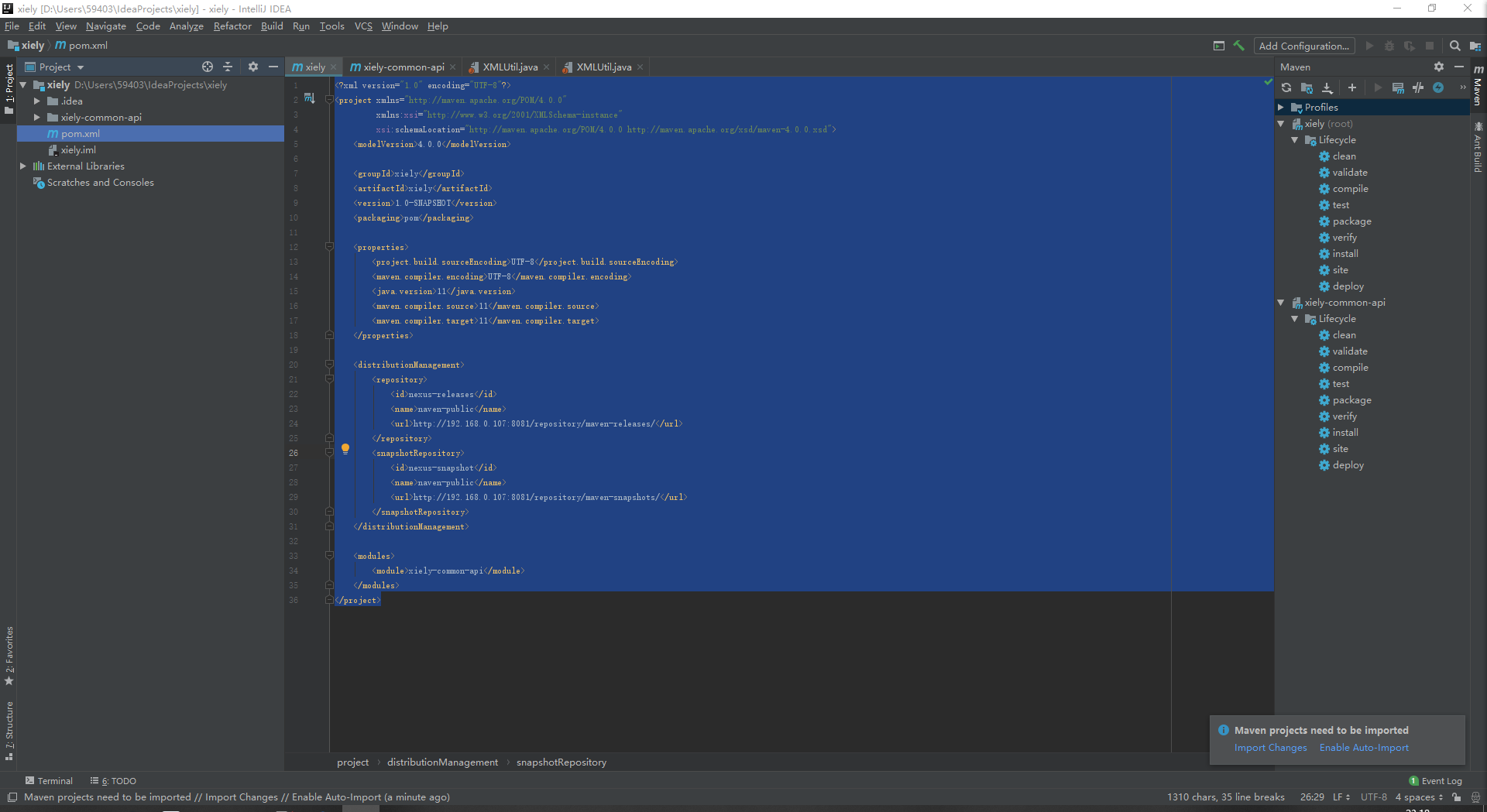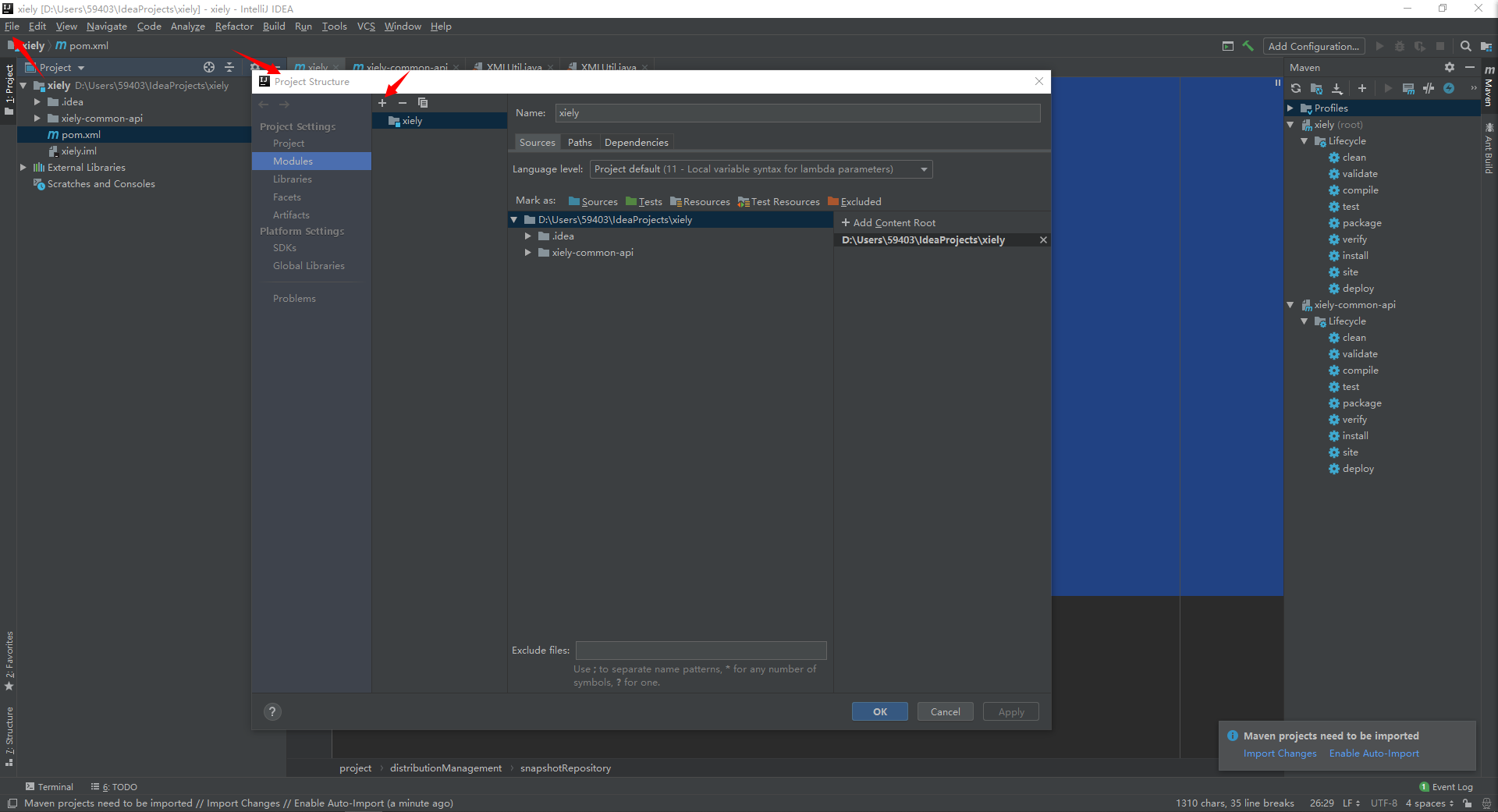准备材料:
Nexus下载地址:https://www.sonatype.com/download-oss-sonatype
IntelliJ IDEA下载地址:https://www.jetbrains.com/idea/download/
Maven配置:
settings.xml配置:(参考https://blog.csdn.net/u013631223/article/details/79082491)

1 <?xml version="1.0" encoding="UTF-8" ?> 2 <settings xmlns="http://maven.apache.org/SETTINGS/1.0.0" 3 xmlns:xsi="http://www.w3.org/2001/XMLSchema-instance" 4 xsi:schemaLocation="http://maven.apache.org/SETTINGS/1.0.0 http://maven.apache.org/xsd/settings-1.0.0.xsd"> 5 6 <!--自定义本地仓库路径--> 7 <localRepository>D:\Users\59403\repository</localRepository> 8 9 <!--Maven是否需要和用户交互以获得输入。如果Maven需要和用户交互以获得输入,则设置成true,反之则应为false。默认为true。 --> 10 <interactiveMode>true</interactiveMode> 11 12 <!--Maven是否需要使用plugin-registry.xml文件来管理插件版本。 --> 13 <!--如果设置为true,则在{user.home}/.m2下需要有一个plugin-registry.xml来对plugin的版本进行管理 --> 14 <!--默认为false。 --> 15 <usePluginRegistry>false</usePluginRegistry> 16 17 <!--表示Maven是否需要在离线模式下运行。如果构建系统需要在离线模式下运行,则为true,默认为false。 --> 18 <!--当由于网络设置原因或者安全因素,构建服务器不能连接远程仓库的时候,该配置就十分有用。 --> 19 <offline>false</offline> 20 21 <!-- 22 当插件的组织Id(groupId)没有显式提供时,供搜寻插件组织Id(groupId)的列表。 23 该元素包含一个pluginGroup元素列表,每个子元素包含了一个组织Id(groupId)。 24 当我们使用某个插件,并且没有在命令行为其提供组织Id(groupId)的时候,Maven就会使用该列表。 25 默认情况下该列表包含了org.apache.maven.plugins。 26 <pluginGroups> 27 plugin的组织Id(groupId) 28 <pluginGroup>org.codehaus.mojo</pluginGroup> 29 </pluginGroups> 30 --> 31 <!-- 32 用来配置不同的代理,多代理profiles可以应对笔记本或移动设备的工作环境:通过简单的设置profile id就可以很容易的更换整个代理配置。 33 <proxies> 34 代理元素包含配置代理时需要的信息 35 <proxy> 36 代理的唯一定义符,用来区分不同的代理元素 37 <id>myproxy</id> 38 该代理是否是激活的那个。true则激活代理。当我们声明了一组代理,而某个时候只需要激活一个代理的时候,该元素就可以派上用处。 39 <active>true</active> 40 代理的协议。 协议://主机名:端口,分隔成离散的元素以方便配置。 41 <protocol>http://…</protocol> 42 代理的主机名。协议://主机名:端口,分隔成离散的元素以方便配置。 43 <host>proxy.somewhere.com</host> 44 代理的端口。协议://主机名:端口,分隔成离散的元素以方便配置。 45 <port>8080</port> 46 代理的用户名,用户名和密码表示代理服务器认证的登录名和密码。 47 <username>proxyuser</username> 48 代理的密码,用户名和密码表示代理服务器认证的登录名和密码。 49 <password>somepassword</password> 50 不该被代理的主机名列表。该列表的分隔符由代理服务器指定;例子中使用了竖线分隔符,使用逗号分隔也很常见。 51 <nonProxyHosts>*.google.com|ibiblio.org</nonProxyHosts> 52 </proxy> 53 </proxies> 54 --> 55 56 <!--配置服务端的一些设置。一些设置如安全证书不应该和pom.xml一起分发。这种类型的信息应该存在于构建服务器上的settings.xml文件中。 --> 57 <servers> 58 <server> 59 <!--这是server的id(注意不是用户登陆的id),该id与distributionManagement中repository元素的id相匹配。 --> 60 <id>nexus-releases</id> 61 <!--鉴权用户名。鉴权用户名和鉴权密码表示服务器认证所需要的登录名和密码。 --> 62 <username>admin</username> 63 <!--鉴权密码 。鉴权用户名和鉴权密码表示服务器认证所需要的登录名和密码。 --> 64 <password>admin123</password> 65 <!-- 66 将来passphrase和password元素可能会被提取到外部,但目前它们必须在settings.xml文件以纯文本的形式声明。 67 <privateKey>${usr.home}/.ssh/id_dsa</privateKey> 68 鉴权时使用的私钥密码。 69 <passphrase>some_passphrase</passphrase> 70 文件被创建时的权限。如果在部署的时候会创建一个仓库文件或者目录,这时候就可以使用权限(permission)。 71 这两个元素合法的值是一个三位数字,其对应了unix文件系统的权限,如664,或者775。 72 <filePermissions>664</filePermissions> 73 --> 74 </server> 75 <server> 76 <id>nexus-snapshot</id> 77 <username>admin</username> 78 <password>admin123</password> 79 </server> 80 </servers> 81 82 <!--为仓库列表配置的下载镜像列表。 --> 83 <mirrors> 84 <!--给定仓库的下载镜像。 --> 85 <mirror> 86 <!--该镜像的唯一标识符。id用来区分不同的mirror元素。 --> 87 <id>nexus</id> 88 <!--镜像名称 --> 89 <name>internal nexus repository</name> 90 <!--该镜像的URL。构建系统会优先考虑使用该URL,而非使用默认的服务器URL。 --> 91 <url>http://192.168.0.107:8081/repository/maven-public/</url> 92 <!--被镜像的服务器的id。例如,如果我们要设置了一个Maven中央仓库(http://repo1.maven.org/maven2)的镜像,--> 93 <!--就需要将该元素设置成central。这必须和中央仓库的id central完全一致。 --> 94 <mirrorOf>*</mirrorOf> 95 </mirror> 96 </mirrors> 97 98 <profiles> 99 <!--根据环境参数来调整的构件的配置 --> 100 <profile> 101 <!--该配置的唯一标识符。 --> 102 <id>nexus</id> 103 <!--远程仓库列表,它是Maven用来填充构建系统本地仓库所使用的一组远程项目。 --> 104 <repositories> 105 <!--包含需要连接到远程仓库的信息 --> 106 <repository> 107 <!--远程仓库唯一标识 --> 108 <id>my-nexus</id> 109 <!--远程仓库名称 --> 110 <name>Nexus</name> 111 <!--远程仓库URL,按protocol://hostname/path形式 --> 112 <url>http://192.168.0.107:8081/repository/maven-public/</url> 113 <!--如何处理远程仓库里发布版本的下载 --> 114 <releases> 115 <!--true或者false表示该仓库是否为下载某种类型构件(发布版,快照版)开启。 --> 116 <enabled>true</enabled> 117 </releases> 118 <!--如何处理远程仓库里快照版本的下载。有了releases和snapshots这两组配置,POM就可以在每个单独的仓库中,为每种类型的构件采取不同的策略。--> 119 <!--例如,可能有人会决定只为开发目的开启对快照版本下载的支持。参见repositories/repository/releases元素 --> 120 <snapshots> 121 <enabled>true</enabled> 122 </snapshots> 123 </repository> 124 </repositories> 125 </profile> 126 </profiles> 127 <!--手动激活profiles的列表,按照profile被应用的顺序定义activeProfile。 该元素包含了一组activeProfile元素,每个activeProfile都含有一个profile id。--> 128 <!--任何在activeProfile中定义的profile id,不论环境设置如何,其对应的 profile都会被激活。--> 129 <!--如果没有匹配的profile,则什么都不会发生。例如,env-test是一个activeProfile,则在pom.xml(或者profile.xml)中对应id的profile会被激活。--> 130 <!--如果运行过程中找不到这样一个profile,Maven则会像往常一样运行。 --> 131 <activeProfiles> 132 <activeProfile>nexus</activeProfile> 133 </activeProfiles> 134 </settings>
父pom.xml:

1 <?xml version="1.0" encoding="UTF-8"?> 2 <project xmlns="http://maven.apache.org/POM/4.0.0" 3 xmlns:xsi="http://www.w3.org/2001/XMLSchema-instance" 4 xsi:schemaLocation="http://maven.apache.org/POM/4.0.0 http://maven.apache.org/xsd/maven-4.0.0.xsd"> 5 <modelVersion>4.0.0</modelVersion> 6 7 <groupId>xiely</groupId> 8 <artifactId>xiely</artifactId> 9 <version>1.0-SNAPSHOT</version> 10 <packaging>pom</packaging> 11 12 <properties> 13 <project.build.sourceEncoding>UTF-8</project.build.sourceEncoding> 14 <maven.compiler.encoding>UTF-8</maven.compiler.encoding> 15 <java.version>11</java.version> 16 <maven.compiler.source>11</maven.compiler.source> 17 <maven.compiler.target>11</maven.compiler.target> 18 </properties> 19 20 <distributionManagement> 21 <repository> 22 <id>nexus-releases</id> 23 <name>naven-public</name> 24 <url>http://192.168.0.107:8081/repository/maven-releases/</url> 25 </repository> 26 <snapshotRepository> 27 <id>nexus-snapshot</id> 28 <name>naven-public</name> 29 <url>http://192.168.0.107:8081/repository/maven-snapshots/</url> 30 </snapshotRepository> 31 </distributionManagement> 32 33 <modules> 34 <module>xiely-common-api</module> 35 </modules> 36 </project>
子pom.xml:

1 <?xml version="1.0" encoding="UTF-8"?> 2 <project xmlns="http://maven.apache.org/POM/4.0.0" 3 xmlns:xsi="http://www.w3.org/2001/XMLSchema-instance" 4 xsi:schemaLocation="http://maven.apache.org/POM/4.0.0 http://maven.apache.org/xsd/maven-4.0.0.xsd"> 5 <modelVersion>4.0.0</modelVersion> 6 7 <parent> 8 <groupId>xiely</groupId> 9 <artifactId>xiely</artifactId> 10 <version>1.0-SNAPSHOT</version> 11 </parent> 12 13 <groupId>xiely-common-api</groupId> 14 <artifactId>xiely-common-api</artifactId> 15 <version>1.0-SNAPSHOT</version> 16 <packaging>jar</packaging> 17 <name>xiely-common-api</name> 18 19 <dependencies> 20 <dependency> 21 <groupId>junit.4.10</groupId> 22 <artifactId>junit.4.10</artifactId> 23 <version>4.10</version> 24 </dependency> 25 <dependency> 26 <groupId>jaxb-api.2.2.7</groupId> 27 <artifactId>jaxb-api.2.2.7</artifactId> 28 <version>2.2.7</version> 29 </dependency> 30 <dependency> 31 <groupId>lombok.1.18.6</groupId> 32 <artifactId>lombok.1.18.6</artifactId> 33 <version>1.18.6</version> 34 </dependency> 35 </dependencies> 36 </project>
启动Nexus:
win+r;D:\Nexus\nexus-3.15.2-01\bin>nexus.exe/run(可配置环境变量简化运行,配置方式如jdk)
D:\Nexus\nexus-3.15.2-01\bin>nexus.exe/run
如图为启动成功:

登陆maven库,浏览器输入:http://{本机ip}:8081/
默认账号:admin/admin123
上传jar包:

创建Maven工程:


填写一些id后,Next就可以了。
配置父pom.xml:

创建子模块:
File->Project Structure->+添加子模块,然后配置子模块的pom.xml

